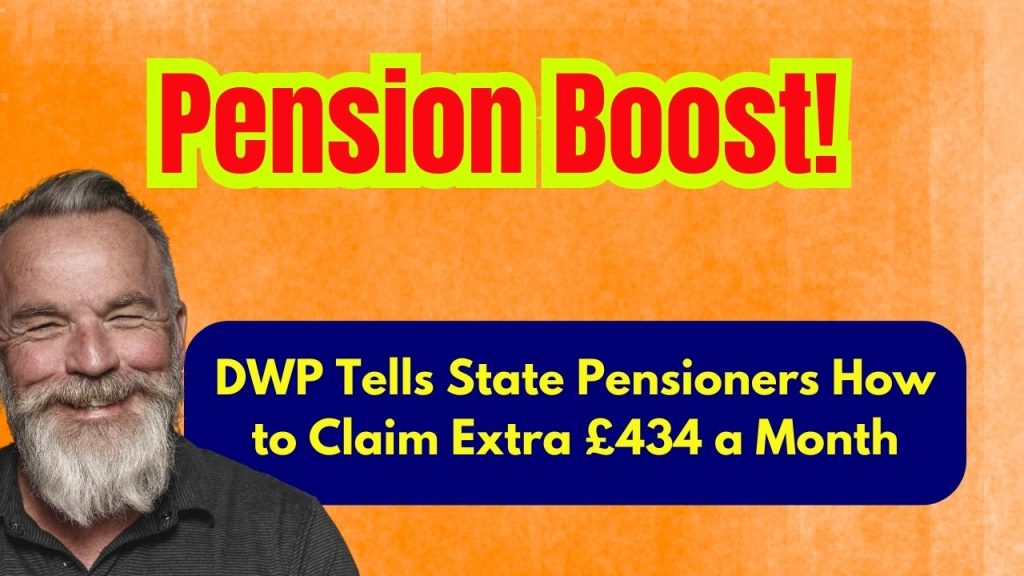DWP Tells State Pensioners How to Claim Extra £434 a Month: For many retirees across the UK, every bit of extra income can make a meaningful difference. That’s why a recent update from the Department for Work and Pensions (DWP) is grabbing attention. Pensioners who are facing long-term health conditions or disabilities may be eligible to receive up to £434.20 extra each month through a support benefit known as Attendance Allowance.

Understanding this benefit can feel overwhelming at first but knowing what’s available could open the door to more independence and a better quality of life. Whether you’re navigating retirement yourself or assisting a loved one, this article will walk you through everything you need to know: what Attendance Allowance is, who qualifies, what the rates are, and how to apply in a straightforward and stress-free way.
DWP Tells State Pensioners How to Claim Extra £434 a Month
| Topic | Details |
|---|---|
| Benefit Name | Attendance Allowance |
| Maximum Amount | £108.55 per week / £434.20 every four weeks |
| Eligibility | Over State Pension age (currently 66), with a long-term illness or disability |
| Payment Rates | £72.65/week (Lower Rate), £108.55/week (Higher Rate) |
| Duration Requirement | Must need care/support for at least 6 months (unless terminally ill) |
| How to Apply | Online (pilot scheme), or by post using a form requested from DWP helpline |
| DWP Helpline Number | 0800 731 0122 |
| Official Website | gov.uk/attendance-allowance |
If you or a loved one is over the State Pension age and living with a disability or long-term health condition, Attendance Allowance could be a game-changing financial support. With payments of up to £434 every month, the benefit is not just about money—it’s about improving your independence, your comfort, and your peace of mind.
Applying might seem overwhelming, but with clear guidance and support, it’s entirely doable. And remember, you don’t need to go through the process alone. Many organizations are ready to help.
What Is Attendance Allowance?
Attendance Allowance is a non-means-tested benefit offered by the UK government through the DWP. It is specifically designed to help older people who have a disability or health condition that makes it difficult to carry out everyday tasks. You do not need to have a formal diagnosis, but you must demonstrate that you require help with personal care or need someone to keep an eye on you for safety reasons.
This benefit is not based on your income or savings, so it won’t be affected by how much money you have. And importantly, you don’t need to have a carer or live in a care home to qualify. You can live independently and still be eligible if you need support.
Common Conditions That May Qualify
A wide range of physical and mental health conditions may entitle you to Attendance Allowance. These include but are not limited to:
- Arthritis (including osteoarthritis and rheumatoid arthritis)
- Dementia, including Alzheimer’s disease
- Chronic heart disease or heart failure
- Chronic obstructive pulmonary disease (COPD) or severe asthma
- Parkinson’s disease
- Neurological disorders (such as multiple sclerosis or epilepsy)
- Vision impairment (partial sight or blindness)
- Hearing loss or deafness
- Severe mobility issues, such as needing help walking or using stairs
It’s important to remember that eligibility depends on the impact of the condition rather than the diagnosis itself. Even a combination of milder issues that affect your day-to-day life may qualify.
Note: You must have experienced these needs for at least six months before applying, unless you are terminally ill, in which case you can apply under special rules for a faster response.
How Much Can You Get?
Attendance Allowance is available at two distinct rates, which depend on the level of help you need and the times of day that help is required.
Lower Rate: £72.65 per week
This rate is available to those who need assistance during the day or at night. It applies if you need frequent help with personal care tasks like washing, dressing, preparing food, or if you need supervision to avoid accidents.
Higher Rate: £108.55 per week
You may qualify for the higher rate if you need support throughout both day and night, or if you’re classified as terminally ill with less than 12 months to live.
That means the maximum benefit is £434.20 every four weeks, which could significantly ease financial pressure. Payments are made directly into your bank, building society, or credit union account.
Why It Matters: More Than Just Money
The impact of Attendance Allowance goes far beyond the direct payments. Receiving this benefit can also be a gateway to additional financial support. Many pensioners don’t realise that being awarded Attendance Allowance could make them eligible for:
- Pension Credit (an income top-up)
- Housing Benefit (to help with rent costs)
- Council Tax Reduction (to cut your council tax bill)
- Carer’s Allowance (if someone is looking after you for at least 35 hours per week)
These additional benefits can make a real difference to your overall financial wellbeing. You might also qualify for extra help such as free TV licences if you’re over 75, or discounts on utility bills.
How to Apply for Attendance Allowance
While the application process may seem complicated, it’s manageable when taken one step at a time. Here’s a comprehensive guide:
Step 1: Request the Application Form
There are two main ways to access the Attendance Allowance claim form:
- Online Application (Pilot Service): The DWP has launched a limited online pilot to test digital applications. You can try it here: Apply online. Slots are limited and fill up fast.
- By Phone: Call the Attendance Allowance helpline at 0800 731 0122 (Monday to Friday, 8am to 6pm). They will send you the paper form and instructions.
Step 2: Complete the Form Thoroughly
When filling out the form, detail your daily challenges clearly. The goal is to show how your condition affects you, not just what your condition is. Include:
- Examples of tasks you struggle with (e.g., bathing, dressing, remembering medication)
- How often you need help
- Whether your needs are consistent or fluctuate
- Safety concerns such as falls or confusion
You can ask for help from Citizens Advice, Age UK, or other local organisations. Having someone assist can make your answers more complete and accurate.
Step 3: Send Off Your Completed Form
Send the filled-out form to the Freepost address given in the application pack. You do not need a stamp or postcode. Keep a photocopy or photo of your completed form for reference.
Tips for a Successful Claim
Filling in the Attendance Allowance form can be challenging, but the following tips can improve your chances of success:
- Be honest and specific: Accurately describe your limitations. Avoid underplaying your difficulties.
- Use real-life examples: Describe specific incidents (e.g., “I fell in the shower because I couldn’t balance”).
- Include medical evidence: Attach copies of any hospital letters, prescriptions, or GP notes.
- Explain variable conditions: If your health fluctuates, describe both good and bad days.
- Don’t leave sections blank: Use the extra pages if needed. More detail is better than too little.
Remember: You can request help from an advice agency to review your form before sending it.
DWP Benefits Increase 2025: Check Important Changes and What They Mean for UK Families!
How to Claim the £230 State Pension Boost in 2025 – Check Eligibility Criteria to Get DWP Increase!
2025 DWP Benefits Update: Check Important Changes UK Families Must Be Aware Of!
FAQs About DWP Tells State Pensioners How to Claim Extra £434 a Month
1. Can I get Attendance Allowance and State Pension?
Yes. Attendance Allowance is separate from your State Pension. It will not affect how much State Pension you receive.
2. Does having a carer affect my claim?
Not at all. You can apply regardless of whether or not you have someone providing care for you.
3. Is Attendance Allowance taxable?
No, this benefit is completely tax-free and does not count as income.
4. Are there restrictions on how I use the money?
There are no restrictions. You can spend it however you choose—whether that’s on hiring help, mobility aids, or paying household bills.
5. How long will it take to hear back?
It usually takes 8 to 10 weeks to receive a decision. If your application is more complex, or additional medical info is needed, it may take longer.
6. Can I appeal if my application is denied?
Yes. If you’re rejected, you can request a mandatory reconsideration and submit further evidence. Many people succeed on appeal.











